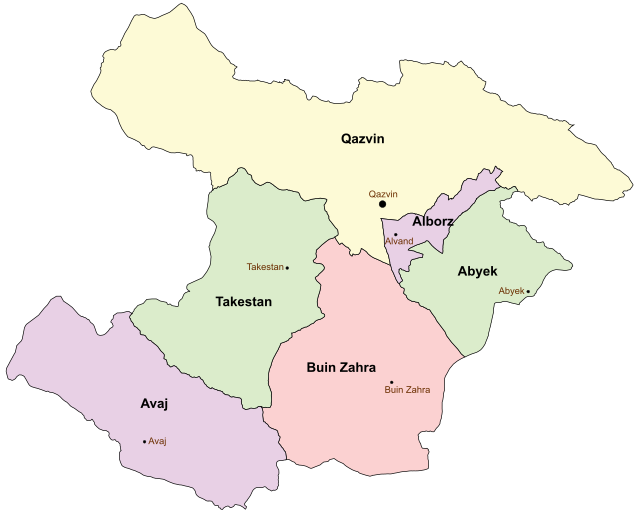Top Qs
Timeline
Chat
Perspective
Qazvin province
Province of Iran From Wikipedia, the free encyclopedia
Remove ads
Qazvin province (Persian: استان قزوین; IPA: [ɢæzˈviːn] ⓘ)[a] is one of the 31 provinces of Iran. It is in the northwest of the country, with the city of Qazvin as its capital.[4]
The province was carved out of Tehran and Zanjan provinces in 1997.[4] The province was made a part of Region 1 upon the division of the provinces into 5 regions solely for coordination and development purposes on June 22, 2014.[3]
Remove ads
History
Summarize
Perspective
Qazvin was the location of a former capital of the Persian Empire and contains over 2000 architectural and archeological sites. It is a provincial capital today that has been a cultural center of mass throughout history.
Archeological findings in the Qazvin plain reveal the existence of urban agricultural settlements as far back as 7000 BC. The name "Qazvin" or "Kasbin" is derived from Cas, an ancient tribe that lived south of the Caspian Sea millennia ago. The Caspian Sea itself in fact derives its name from the same origin. Qazvin geographically connects Tehran, Isfahan, and the Persian Gulf to the Caspian seacoast and Asia Minor, hence its strategic location throughout the ages.
Qazvin has been a hotbed of historical developments in Iranian history. In the early years of the Islamic era Qazvin served as a base for the Muslim forces. Destroyed by Genghis Khan (13th century), the Safavid monarchs made Qazvin the capital of the Safavid empire in 1548 only to have it moved to Isfahan in 1598. During the Qajar dynasty and contemporary period, Qazvin has always been one of the most important governmental centers due to its proximity to Tehran. Abbas Mirza, a Crown Prince and Minister of Commerce, was also the governor of Qazvin.
Qazvin is situated close to Alamut, where the famous Hasan-i Sabbah, founder of the secret Ismaili order of the Assassins, operated from.
Qazvin is where the coup d'état of General Reza Khan, with his Russian-trained Cossack brigade, was launched from – which led to the founding of the Pahlavi dynasty in 1921.
1962 Buin Zahra earthquake killed 12.225 people.
Remove ads
Demographics
Summarize
Perspective
Language and ethnicity
The majority of people in the northeast of the province, in Alamut, are Mazandarani or Gilaks who speak a dialect of the Mazandarani[7][8][9] or Gilaki language.[10][11] Other sources say that the majority of people in Alamut are Tats.[12][13]
Population
At the time of the 2006 National Census, the province's population was 1,127,734 in 294,305 households.[14] The following census in 2011 counted 1,201,565 inhabitants living in 352,472 households.[15] The 2016 census measured the population of the province as 1,273,761 people in 397,165 households.[5]
Administrative divisions
The population history and structural changes of Qazvin province's administrative divisions over three consecutive censuses are shown in the following table.
Cities
According to the 2016 census, 952,149 people (nearly 75% of the population of Qazvin province) live in the following cities:[5]
Remove ads
Geography

The province covers 15821 km2 between 48–45 to 50–50 east of Greenwich Meridian of longitude and 35–37 to 36–45 north latitude of the equator. The province is bounded on the north by Mazandaran and Gilan, on the west by Hamedan and Zanjan, on the south by Markazi and on the east by Tehran Provinces. The famous mountains of the province are those of Siälän, Shäh Alborz, Khashchäl, Sephidkouh, Shojä e din, Alehtareh, Rämand, Ägh dägh, Kharaghän, Saridagh, Soltan pïr, and Siähkouh, in which Siälän with a height of 4,175m and Shäh Alborz which is 4,056m are the highest. All are part of the central chain of Alborz. The lowest point of the province is in Tärom e Soflä.
Climate
The climate of the province in the northern parts is cold and snowy in winters and temperate in summers. In the southern parts, the climate is mild with comparatively cold winters and warm summers.
Notable sites
Historical mosques
- Al-Nabi Mosque (Soltani Mosque)
- Peighambarieh Shrine: Where four Jewish saints who are said to have foretold the coming of Jesus are buried.[17][18][19]
Castles and forts
These are castles and fortifications mostly from the Isma'ili movement of the Middle Ages:
Traditional reservoirs
Of the approximately 100 water reservoirs that were formerly in Qazvin, the transmission 10 are protected by the Provincial Cultural Heritage Organization. See: List of famous ab anbars of Qazvin
Bazaars and caravanserais
Bridges
Notable parks
Remove ads
Colleges and universities
Notable people
- Ali Akbar Dehkhoda: linguist and lexicographer, was originally from Qazvin.
- Obeid Zakani: poet (d. 1370)
- Hamdollah Mostowfi: historian and writer (1281–1349)
- Táhirih; 19th century poet, women's rights and religious activist
See also
Notes
- Also romanized as Ostān-e Qazvīn
- Separated from Buin Zahra County after the 2011 census[16]
References
External links
Wikiwand - on
Seamless Wikipedia browsing. On steroids.
Remove ads



